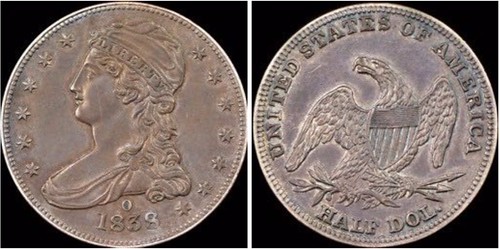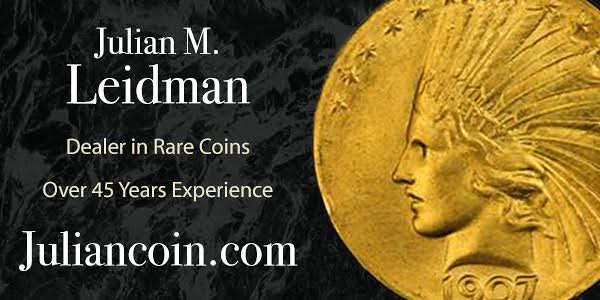
PREV ARTICLE
NEXT ARTICLE
FULL ISSUE
PREV FULL ISSUE
1838-O HALF DOLLAR RESEARCH
Kin Carmody submitted this summary of his recent research into the 1838-O half dollars. Thanks! A link to his full paper is below.
-Editor

NEW RESEARCH PROVES THAT THE TYLER/BACHE SPECIMEN
In January-March 2016, NGC conducted an exhaustive out of holder examination of the TYLER/BACHE 1838-O half dollar. It is one of only nine known specimens, and the purpose of this review was to determine if it had characteristics that made it different from the other eight. SUMMARY OF RESEARCH FINDINGS 1) The Tyler/Bache specimen has the least developed GR-1 die crack on the reverse and it is therefore the earliest produced of all the known survivors. 2) The Tyler/Bache specimen has dentil distress marks on its lower reverse that were made by the loose reverse die at the end of the Jan1839 original (first) production run. This run was intended to test the large dollar press in order to make coins for circulation, but the reverse die support system collapsed after only 10 coins were struck, and it was not possible to make more at that time. 3) No other specimens have even the slightest reverse marks that could be attributable to the loose reverse die. These marks would have to be present if the others were produced in this same run because they were all struck later than Tyler/Bache and have more developed GR-1die cracks. Therefore, Tyler/Bache MUST BE THE ONLY SURVIVOR FROM THE ORIGINAL RUN. 4) The Tyler/Bache specimen has a weak/shallow strike. This weak strike is due to two factors. First, the coins in this original run were intended for circulation rather than as proofs for the Mint Director. Second, the original run had to use the dollar press because the half dollar press was not ready for production. The reverse half dollar die was too short to be secured into the larger dollar press, and Rufus Tyler, the Chief Coiner, had to splice it into place. We can infer that Tyler would have used lower striking pressure on his "jury rigged" system in an attempt to reduce the risk of failure. All the other specimens have very strong, sharp, strikes that are stronger than even the PROOF 1838 half dollars made in Philadelphia. We can conclude that these other specimens COULD NOT HAVE BEEN MADE ON THE DOLLAR PRESS AT A LATER DATE because their strikes are too strong. 5) All other specimens are PROOFS Produced at a later date on the half dollar press for Mint Director Patterson. OVERALL CONCLUSION All known 1838-O half dollars fall into two groups. They are : ORIGINALS
PROOF RESTRIKES
For the full text of the research study, please click on this URL. Please note that Dropbox will ask you to sign up, but this is not necessary. Just click on "skip this step":
Few American coins have a history and rarity that can equal that of the TYLER/BACHE half
dollar. In the 19th century the origins of the 1838-O half dollar were unknown, as there were no mint
records of its production. As late as 1890, some numismatists believed that no more than 3
specimens existed, and it was considered to be among the rarest of all American coins.
Then, on June 7/8
1894, Ed. Frossard held an auction of the William Friesner collection in New York and an 1838-O half
dollar was listed as item number 583. The coin was purchased by famed Numismatist and author
Augustus Heaton, and his initials can still be seen next to the listing in Frossard's personal copy of the
auction catalog. Heaton had published his book "A TREATISE ON COINAGE OF THE UNITED 1
STATES BRANCH MINTS " in 1893 which led to numismatic interest in the collection of mint marks in
addition to dates, and the 1838-O half dollar was prominently referenced in his book on pages 28 and 29.
After purchasing this prized item, Heaton made inquiries as to its origin. As a result of these inquiries, a
note from Rufus Tyler, Chief Coiner of the New Orleans Mint, was discovered, and this was the first clue as
to the origins of this famed rarity.
|

